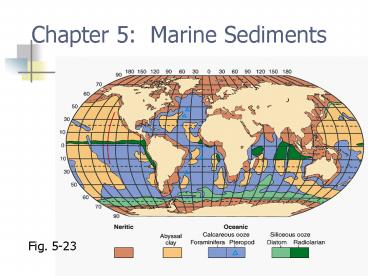Chapter 5: Marine Sediments - PowerPoint PPT Presentation
1 / 21
Title:
Chapter 5: Marine Sediments
Description:
... history Sediments lithified Mineral composition Sedimentary texture Past climate Plate motions Age of seafloor Fossil evolution and ... protozoans, Radiolaria ... – PowerPoint PPT presentation
Number of Views:127
Avg rating:3.0/5.0
Title: Chapter 5: Marine Sediments
1
Chapter 5 Marine Sediments
Fig. 5-23
2
Sediments reveal Earth history
- Sediments lithified
- Mineral composition
- Sedimentary texture
- Past climate
- Plate motions
- Age of seafloor
- Fossil evolution and extinction
3
Sediments classified by origin
- Lithogenous
- Biogenous
- Hydrogenous
- Cosmogenous
4
Lithogenous sediments
- Rock fragments from land
- Transported to oceans by
- Rivers
- Wind
- Ice
- Gravity flows
5
Rivers transport much sediment
Fig. 5-5
6
- Most lithogenous sediments accumulate near
continental margins - Wind-blown dust in deep ocean makes abyssal clay
(red clay) - Mostly quartz (SiO2)
- Chemically stable
- Abrasion resistant
7
Distribution of terrigenous sediments
- Neritic mainly lithogenous
- Coarser particles closer to shore
- Beach sands, continental shelf deposits,
turbidite deposits, glacial deposits - Pelagic
- Finer particles farther from land
- Wind blown or distal turbidite
8
Biogenous sediments
- Hard parts of once-living organisms
- Shells, teeth, bones
Fig. 5-10
9
- Calcareous ooze (CaCO3)
- Microscopic protozoans, foraminifer
- Microscopic algae, coccolithophores
- Siliceous ooze (SiO2)
- Microscopic protozoans, Radiolaria
- Microscopic algae, diatoms
10
Distribution of biogenic sediments
- Ooze is 30 or more biogenic material (by weight)
- Biologic productivity
- Dissolution as shells settle through ocean
- Dilution by non-biogenic material
11
Shells and silt-clay fall through seawater column
to seafloor
12
- Neritic biogenic sediments
- Modern carbonates shallow, warm ocean
- Coral reefs
- Ooid shoals
- Beach sands
- Stromatolites hypersaline
13
- Pelagic biogenic sediments
- Siliceous ooze beneath areas of surface ocean
upwelling (high biologic productivity) - Calcareous ooze on seafloor less than about 4500
m - CaCO3 dissolves in cold seawater
14
Hydrogenous sediments
- Dissolved ions precipitate from seawater
- Manganese nodules
- Inorganic carbonates
- Metallic sulfides
- Evaporites
15
Manganese nodules
- Very low rate of accumulation
- Larger nodules grow larger faster
- Origin is unknown
Fig. 5-18
16
Cosmogenous sediments
- Extraterrestrial fragments
- Glassy tektites
- Fe-Ni micrometeorites
- Found in deep ocean where other sediments
accumulate very slowly
17
Mixtures of sediment types
- Most marine sediments are mixtures of the four
types of sediment - Usually one sediment type is dominant
18
Mixed marine sediments
- Examples
- Neritic seds mainly lithogenous although shell
fragments are common - Coarse calcareous rubble in shallow tropical
oceans mixed with quartz
19
- Calcareous ooze most common in deep sea floor
(water depth lt 4500m) - Abyssal clay most common in deeper ocean
20
Distribution of marine seds
Fig. 5-23
21
Fig. 5E































